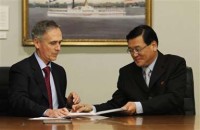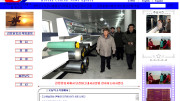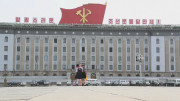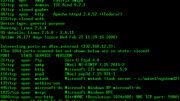Pyongyang is suddenly the hottest place to have a newsroom.
In the space of two weeks, both The Associated Press and Reuters have announced plans to source more content from inside the country.
 The AP has signed a memorandum of understanding (which typically precedes an official deal) on the establishment of a text and photo bureau in Pyongyang, while Reuters says it has an agreement to feed video from Pyongyang for distribution to its TV clients worldwide.
The AP has signed a memorandum of understanding (which typically precedes an official deal) on the establishment of a text and photo bureau in Pyongyang, while Reuters says it has an agreement to feed video from Pyongyang for distribution to its TV clients worldwide.
(Pictured right: Kim Pyong Ho, president of Korean Central News Agency, right, exchanges an agreement during an official signing with AP President and CEO Tom Curley Tuesday, June 28, 2011 in New York.)
The deals were signed with the Korean Central News Agency (KCNA), which both western news agencies have previously described as the government “mouthpiece.” But, when it comes to opening a Pyongyang bureau, there really is no alternative but to deal with KCNA.
Getting access to North Korea for even a short reporting trip is an exercise in frustration, so both news agencies will be hoping that having a more formal arrangement in place will make access to the country easier.
With the country still very much in the news and the 100-year anniversary of the birth of Kim Il Sung approaching next year, both AP and Reuters could be well placed to profit from the new access agreements.
It’s not surprising they seem pretty pleased about their agreements.
The AP noted:
It would be the first permanent text and photo bureau operated by a Western news organization in the North Korean capital. – AP news release, June 29, 2011
While Reuters said:
The Reuters News Agency will be the first international news organization to have a full time satellite dish in North Korea, delivering clean news video content in addition to the text and pictures covered by a previous agreement – a significant benefit to broadcasters across the globe. – Reuters news release, July 11, 2011
AP Television News, a competitor to Reuters TV for the business of broadcasters worldwide, has had a video bureau in Pyongyang since 2006 so Reuters is playing catch-up here.
The “clean” video reference refers to video without the logo or captions of the originating TV station while the perhaps oblique reference to a “full time satellite dish” is probably a jibe at APTN.
APTN uses the facilities of state broadcaster KRT to play out video and live signals so Reuters is keen to trumpet its own dish, but whether that actually makes a difference to the pictures being delivered remains to be seen.
Reuters appears hopeful the deal will mean “up to the minute video stories from Pyongyang and across the country,” but they won’t be coming from Reuters cameras. The deal doesn’t include a full time staffer in Pyongyang, but KCNA will apparently arrange regular visits for “senior Reuters journalists.”
It’s also worth noting that the AP announcement from late June also included a video component. AP signed as the “exclusive distributor of contemporary and historic video from KCNA’s archive.”
Both deals include some sweeteners for KCNA. AP will offer “cooperation on journalistic and photo/video technology issues” and Reuters is promising “editorial training.”




